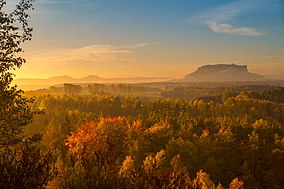Saxon Switzerland National Park
| Saxon Switzerland National Park | |
|---|---|
| Nationalpark Sächsische Schweiz | |
 View of the Lilienstein in Saxon Switzerland | |
| Location | |
| Nearest city | Dresden |
| Coordinates | 50°54′51″N 14°16′42″E / 50.91417°N 14.27833°E |
| Area | 93.5 km² |
| Established | 1990 |
Saxon Switzerland National Park (Template:Lang-de), is a national park in the German Free State of Saxony, near the Saxon capital Dresden. It covers two areas of 93.5 km² (36.1 mi²) in the heart of the German part of the Elbe Sandstone Mountains, which is often called (the) Saxon Switzerland (Template:Lang-de).
The national park adjoins Bohemian Switzerland National Park (Template:Lang-cz) in the Czech Republic.
Geography
Location
The National Park is situated in the centre of a natural area of almost 710 km² (274 mi²). This region, called Saxon Switzerland is cultivated by humans in many places. Smaller towns and villages such as Bad Schandau or Königstein in the district of Sächsische Schweiz are part of this region.
The core area of the National Park has a quiescent area of 40% and is covered almost completely by woodland. The status of National Park, which grants the highest natural protection in Germany, was attributed in 1990. The park lies – in two geographically separate areas – within the district of Sächsische Schweiz-Osterzgebirge.
Landscape
Saxon Switzerland is an intensively fissured and rocky canyon landscape. The highest peak of the National Park is at 556 meters (1,814 feet) above sea level, but is only a short distance from the valley of the Elbe river at 110 to 120 meters (360 to 390 feet). It offers several different habitats and microclimate zones due to its strong vertical division. The National Park still hosts some forms of forest without human intervention, which is unusual in central Europe. The special forms of mountain forest and gorge forest are endangered in Europe generally. Because of the sabulous soil and fissures, many places in this area are drier than normal for the temperate zone.
Western region
This region includes the Bastei area, the Lilienstein and the Polenz valley. In the west it is bordered by Wehlen and Lohmen, in the north by Lohmen and Hohnstein, in the east by Hohnstein and Goßdorf and in the south by Porschdorf, Rathen and Wehlen. The municipality of Waitzdorf lies entirely within the western region. Important peaks are the Lilienstein (415 m), the Bastei (305 m), the Hockstein and the Brand (317 m). The Grünbach and the associated lake of Amselsee and the Polenz are the only noteworthy bodies of water.
Eastern region
The eastern region includes the area of the Schrammsteine rocks, the Großer Winterberg mountain, the Großer Zschand valley and the hinterland of Saxon Switzerland (Hinterer Sächsischen Schweiz). To the west it is bordered by Bad Schandau and Altendorf and to the north by Altendorf, Ottendorf and Hinterhermsdorf. To the east and south it is bordered by the Bohemian Switzerland National Park. From Schmilka to Bad Schandau the Elbe forms the southern boundary of this region. Important peaks are the Großer Winterberg (556 m), the Kuhstall (337 m) and the Raumberg (459 m). The Kirnitzsch is the only noteworthy body of water.[1] [2]
Tourism and recreation

The definition of national Park is, in some cases, in conflict with tourism and recreation. One objective is to raise the inviolate area to 75%, which means limiting the areas of hiking and climbing.
The development of the network of paths in today's national park took place in the first half of the 19th century and completed at the beginning of the 20th century. The historical route guides illustrate it thoroughly (e.g., Meinhold's route guide). The first hiking restrictions were declared as early as in the 1980s (Thorwalder Wände ridge path). Today the National Park has a marked network of 400 km of hiking trails, numerous mountain restaurants, and some 50 km of cycling trails. It is compulsory to use marked routes in the National Park. Though visitors may use all paths outside the core zone, only marked trails are allowed within the core zone.
The painter's way
The painter's way (Malersweg in German) represents only a small part of the park area, but due to its beauty and being a well-developed trail, most visitors prefer it for hiking. The Bastei bridge is the first view of the Valley for many visitors and is extensively photographed and documented.
Rock climbing
The peculiar form of the sandstone cliffs in Saxon Switzerland national park attracts crowds of climbers every year. However, since these cliffs are sandstone, it is important to treat them with cautioun.

The following rules, introduced at the beginning of the 20th century, are in place to preserve the national park sandstones:
- Visitors are not permitted to climb when the rock is wet or crumbling.
- Ropes are only allowed for safety purposes and abseiling.
- Metal safety equipment, such as chock-stones and solid rings, are forbidden.
- Visitors are not allowed to use chemical aids such as magnesia.
- The rock surface must not be modified – except to attach retaining rings on first ascents.
Information posts
- National Park Headquarters
- National Park Centre in Bad Schandau
- National Park Office in Bad Schandau
- Information posts
- Schweizerhaus on the Bastei
- Amselfall mountain hut
- Log cabin on the Brand
- Eishaus on the Großer Winterberg
- Armoury in the Großer Zschand
- Haus Beize and Waldhusche in Hinterhermsdorf
Points of interest
- Pflanzengarten Bad Schandau, a regional botanical garden
- Bastei Bridge
See also
References
- ^ Topografische Karte und Begleitheft Sächsisch-Böhmische Schweiz, Landesvermessungsamt Sachsen, Dresden 2003, ISBN 3-89679-361-6
- ^ https://www.gesetze-im-internet.de/bundesrecht/natpsschweizv/gesamt.pdf [bare URL PDF]

